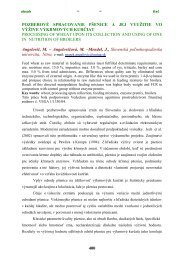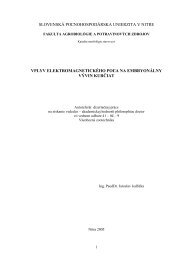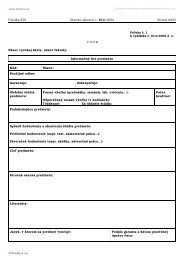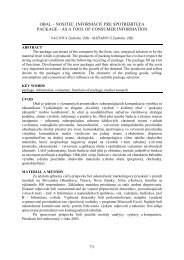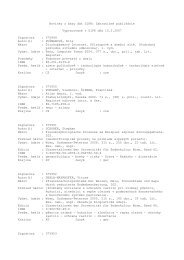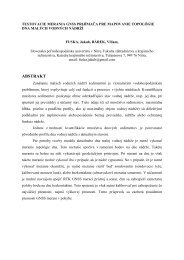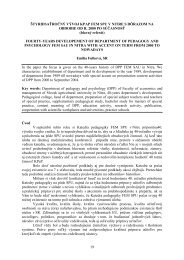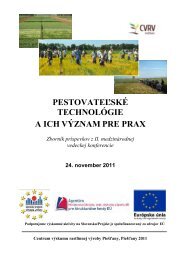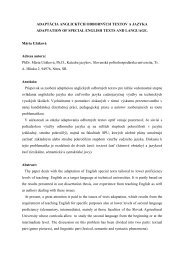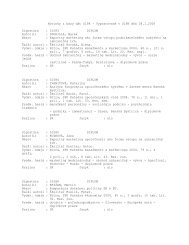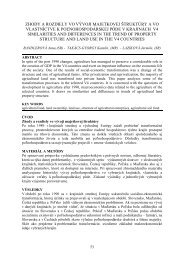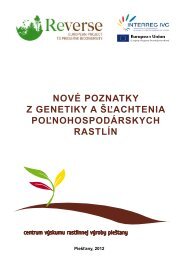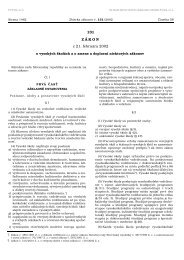Acta fytotechnica et zootechnica, Vol. 4, 2001, Special Number ...
Acta fytotechnica et zootechnica, Vol. 4, 2001, Special Number ...
Acta fytotechnica et zootechnica, Vol. 4, 2001, Special Number ...
You also want an ePaper? Increase the reach of your titles
YUMPU automatically turns print PDFs into web optimized ePapers that Google loves.
<strong>Acta</strong> <strong>fytotechnica</strong> <strong>et</strong> <strong>zootechnica</strong>, <strong>Vol</strong>. 4, <strong>2001</strong>, <strong>Special</strong> <strong>Number</strong><br />
Proceedings of the International Scientific Conference on the Occasion of the 55 th Anniversary of the Slovak Agricultural<br />
University in Nitra<br />
In sustainable crop production it is very important to know precisely the agroecological conditions of crop management.<br />
Within that we have to study the climatic, soil, geographical conditions, we have to adapt the crop management to the<br />
agroecological conditions (site-specific models), and we want to avoid the environmental pollution in different<br />
agroecosystems. In the field of biological-gen<strong>et</strong>ic factors we have to improve the biodiversity, to breed new genotypes and<br />
we have to integrate the biological and agrotechnical elements (vari<strong>et</strong>y-specific technologies).<br />
In sustainable agriculture we have to increasingly rely on the interactions among the different agrotechnical elements. The<br />
fertilization plays a central role in the agrotechnical elements of sustainable agriculture (direct and indirect effect of<br />
fertilization). Reducing external, industrial inputs is also an important issue.<br />
In the sustainable agricultural system we have to improve the usage of interactions among agroecological, biological ang<br />
agrotechnical factors.<br />
The crop quality and its improvement has also a central role in this system.<br />
We have to keep in our mind that every production system should be economically viable which need some governemental<br />
and other mark<strong>et</strong> helps and preferences.<br />
It is also very important that the soci<strong>et</strong>y should accept the programme and m<strong>et</strong>hods of sustainable agriculture. It means not<br />
only an increasing and special demand of good quality and healthy food, but a special thinking of the majority of soci<strong>et</strong>y<br />
concerning the farming practice (energy-saving, low-input m<strong>et</strong>hods <strong>et</strong>c.) and concerning the environmental protection (to<br />
avoid, not ameliorate the pollutions in the agroecosystems).<br />
We are sure that we have to change our thinking about the principles of crop production (for example in wheat<br />
management). In the past we wanted to carry out, to make the optimum values of different agrotechnical factors, because<br />
our main aim was to obtain the maximum yield. The quality of crops had less importance. At present and in the future we<br />
want to carry out the necessary minimum values of many agrotechnical elements and to make optimum values of some<br />
critical factors (like fertilization <strong>et</strong>c.) to obtain optimum yield with good quality of crop products.<br />
Theor<strong>et</strong>ically in the sustainable crop management different technologies could be (extensive, low-input, mid-tech, intensive)<br />
but in our (Hungarian) conditions we can use widly two technologies: low input and mid-tech.<br />
In our polifactorial research project we study the different crop management models in wheat production. The table 1. shows<br />
good results with the using of appropriate technological elements (in the cases of LISA and mid-tech [b] we got the same<br />
yields [7 t/ha] as in the case of intensive model). The economical efficiency and environmental pollution are strongly higher<br />
in intensive model, than in mid-tech or LISA models.<br />
Table 1 Different crop management models in winter wheat production<br />
Crop model Forecrop Genotype<br />
Planting<br />
mode<br />
Plant production<br />
N-fert.<br />
(kg/ha)<br />
Yield<br />
(kg/ha)<br />
Yield difference<br />
(kg/ha) %<br />
Extensive<br />
LISA<br />
Mid-tech(a)<br />
Mid-tech(b)<br />
Intensive(a)<br />
Intensive(b)<br />
w.wheat<br />
peas<br />
w.wheat<br />
peas<br />
w.wheat<br />
peas<br />
Mv 15<br />
Fatima 2<br />
Fatima 2<br />
Mv 15<br />
Mv 15<br />
Mv 15<br />
normal<br />
new<br />
new<br />
normal<br />
normal<br />
normal<br />
conventional<br />
env.friendly<br />
conventional<br />
env.friendly<br />
conventional<br />
conventional<br />
0+0<br />
30+0<br />
30+30<br />
30+30<br />
60+30<br />
30+30<br />
4217<br />
6958<br />
4912<br />
6895<br />
5470<br />
7017<br />
0<br />
2741<br />
695<br />
2678<br />
1253<br />
2800<br />
100,0<br />
165,0<br />
116,5<br />
163,5<br />
129,7<br />
166,4<br />
Among the production elements fertilization has central and integrated role on the increasement of agronomic and economic<br />
efficiency and on the environmental hazards and protection in wheat production. Our long-term experimental results pointed<br />
out that the average-yield without fertilization (control) was 4439 kg/ha and we obtained fairly good yield surplus (2162 kg/ha<br />
in average) with the application of optimum doses of NPK fertilizers (average yield was 6601 kg/ha). This good extra-yield<br />
was obtained on chernozem soil characterised by excellent natural physical, chemical and nutrient-supply characteristics.<br />
In extreme (like continental) climatic conditions it is very important to reduce, to minimise the harmful climatic effects on crop<br />
(wheat) production. With the appropriate fertilization and the precise application of other agrotechnical elements we could<br />
reduce the unfavourable effects of ecological factors. Our scientific results pointed out that the optimum fertilization could<br />
increase the yield stability. In control treatment the fluctuation interval of yield was much higher (71 %) than in the optimum<br />
fertilizer application (48 %). The apprepriate fertilization could increase the water-utilisation of crops (wheat). In optimum<br />
fertilization the yield-surpluses per one unit precipitation in different periods of veg<strong>et</strong>ation time were much higher comparing<br />
with control coefficients (in control 8-20 kg mm -1 rainfall, in optimum NPK doses 15-28 kg mm -1 rainfall).<br />
Our long-term experiments proved that the optimum doses of NPK fertilizers (mainly N) and the efficiency of fertilization were<br />
affected by not only ecological factors (cropyear, soil) but were strongly modified by agrotechnical elements.<br />
In harmonised fertilization (NPK and others) the most important element is nitrogen because of its very active role in the<br />
physiological processes in plants and its special mineralizations in soils. Our long-term experimental results proved that the<br />
optimum N-doses varied from 60 kg/ha to 120 kg/ha on chernozem soil depending on cropyears, agrotechnical elements and<br />
genotypes. For the d<strong>et</strong>ermination of fertilizer responses of different wheat genotypes we used the following param<strong>et</strong>ers:<br />
11



